
Emilio Aguinaldo y Famy was a Filipino revolutionary, statesman, and military leader who is officially recognized as the first and the youngest president of the Philippines (1899–1901) and the first president of a constitutional republic in Asia. He led Philippine forces first against Spain in the Philippine Revolution (1896–1898), then in the Spanish–American War (1898), and finally against the United States during the Philippine–American War (1899–1901).
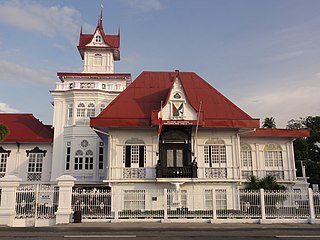
Cavite, officially the Province of Cavite, is a province in the Philippines located in the Calabarzon region in Luzon. Located on the southern shores of Manila Bay and southwest of Metro Manila, it is one of the most industrialized and fastest-growing provinces in the Philippines. As of 2020, it has a population of 4,344,829, making it the most populated province in the country if the independent cities of Cebu are excluded from Cebu's population figure.

Tagaytay, officially the City of Tagaytay, is a 2nd class component city in the province of Cavite, Philippines. According to the 2020 census, it has a population of 85,330 people.

Bacoor, officially the City of Bacoor, is a 1st class component city in the province of Cavite, Philippines. According to the 2020 census, it has a population of 664,625 people, making it the 15th most populous city in the Philippines and the second largest city in the province of Cavite after Dasmariñas.

Dasmariñas, officially the City of Dasmariñas, often shortened to Dasma, is a 1st class component city in the province of Cavite, Philippines.

Imus, officially the City of Imus, is a 3rd class component city and de jure capital of the province of Cavite, Philippines. According to the 2020 census, it has a population of 496,794 people.

Kawit, officially the Municipality of Kawit, is a first-class municipality in the province of Cavite, Philippines. According to the 2020 census, it has a population of 107,535. It is one of the notable places that had a major role in the country's history during the 1800s and 1900s.
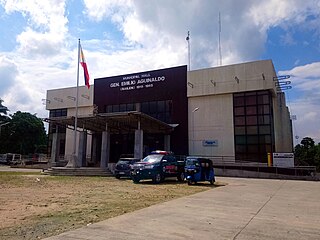
General Emilio Aguinaldo, officially the Municipality of General Emilio Aguinaldo, is a 5th class municipality in the province of Cavite, Philippines. According to the 2020 census, it has a population of 23,973 people.

Mendez, officially the Municipality of Mendez-Nuñez, is a 4th class municipality in the province of Cavite, Philippines. According to the 2020 census, it has a population of 34,879 people.

The Manila–Cavite Expressway (CAVITEX), signed as E3 of the Philippine expressway network and R-1 of Metro Manila's arterial road network, is a 14-kilometer-long (8.7 mi) controlled-access toll expressway linking Manila to the southern province of Cavite in the Philippines. At its north end, it feeds into and from Roxas Boulevard in the city of Parañaque in Metro Manila, also part of R-1. At the south end, it splits into two termini, both along the north coast in Kawit, Cavite. The first feeds into the intersection of Tirona Highway and Antero Soriano Highway. The second southern terminus is on the intersection of Tirona Highway and Antero Soriano Highway near the Aguinaldo Shrine.
The legislative districts of Cavite are the representations of the province of Cavite in the various national legislatures of the Philippines. The province is currently represented in the lower house of the Congress of the Philippines through its first, second, third, fourth, fifth, sixth, seventh, and eighth congressional districts.

The Tejeros Convention, also known as the Tejeros Assembly and the Tejeros Congress, was a meeting held on March 22, 1897 between Katipunan factions of Magdiwang and Magdalo in San Francisco de Malabon, Cavite that resulted in the creation of a new revolutionary government that took charge of the Philippine Revolution, replacing the Katipunan. It followed on a previous meeting now known as the Imus Assembly. Filipino historians consider the first presidential and vice presidential elections in Philippine history to have been held at this convention, although only Katipuneros were able to take part, and not the general populace.

Radial Road 2 (R-2), informally known as the R-2 Road, is a network of roads and bridges that all together form the second arterial road of Metro Manila in the Philippines. Spanning some 64.2 kilometers (39.9 mi), it connects the cities and municipalities of Bacoor, Dasmariñas, Imus, Las Piñas, Manila, Parañaque, Pasay, Silang, and Tagaytay in Cavite and Metro Manila.

Juanito R. Remulla Sr. Road, formerly and still referred to as Governor's Drive, is a two-to-nine lane, 58.3-kilometer (36.2 mi) network of primary, secondary and tertiary highways and bridges traversing through the central cities and municipalities of the province of Cavite, Philippines. It is the widest of the three major highways located in the province, the others are Aguinaldo Highway and Antero Soriano Highway.
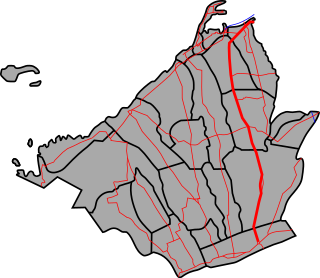
The Emilio Aguinaldo Highway,, alternatively known as Cavite–Batangas Road and Cavite-Manila South Road, is a four-to-six lane, 41.4-kilometer (25.7 mi), network of primary and secondary highways passing through the busiest towns and cities of Cavite, Philippines. It is the busiest and most congested of the three major highways located in the province, the others are Governor's Drive and Antero Soriano Highway.
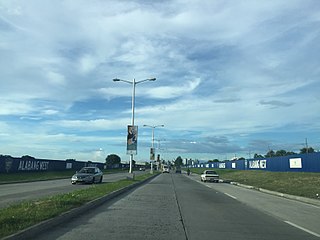
Daang Hari, also known as the Las Piñas–Muntinlupa–Laguna–Cavite Link Road, is a collector road that links southern Metro Manila to the province of Cavite in the Philippines. It begins as a north–south road from Commerce Avenue, just south of the Alabang–Zapote Road running for 5.9 kilometers (3.7 mi) on the boundary of Las Piñas and Muntinlupa. It then runs east–west for about 9.2 kilometers (5.7 mi) from its junction with Daang Reyna, winding through the cities of Bacoor, Imus, Dasmariñas, and General Trias.
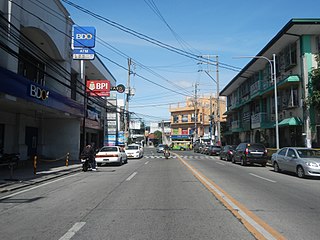
Elpidio Quirino Avenue, also known simply as Quirino Avenue, is a major north-south collector road in Parañaque, southern Metro Manila, Philippines. It is a four-lane undivided arterial running parallel to Roxas Boulevard and its extension, the Manila–Cavite Expressway, to the west from Baclaran at Parañaque's border with Pasay in the north to San Dionisio right by the border with Las Piñas in the south. It is a continuation of Harrison Avenue from Pasay and was originally a segment of the coastal highway called Calle Real. The entire road is a component of Radial Road 2 (R-2) of Manila's arterial road network, while its segment south of NAIA Road is a component of National Route 62 (N62) of the Philippine highway network. It was named after President Elpidio Quirino. The road's name is also applied alternatively to Diego Cera Avenue in Las Piñas.

The Tagaytay–Nasugbu Highway, alternatively known as Tagaytay–Nasugbu Road and formerly as Tagaytay–Tuy–Nasugbu Port Road, is a 43.86-kilometer (27.25 mi), two-to-four lane, secondary highway in the provinces of Cavite and Batangas, Philippines, that connects the city of Tagaytay in Cavite and the municipality of Nasugbu in Batangas.
The National Route 62 (N62) forms part of the Philippine highway network. It runs south from Metro Manila to northeastern Cavite.
The National Route 410 (N410) forms part of the Philippine highway network. It runs in southern Cavite to Batangas.
















